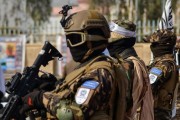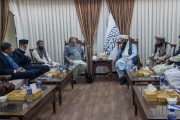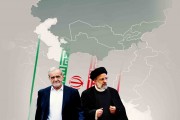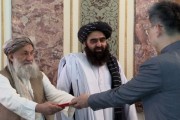Publish Date
Wednesday 26 October 2022 - 11:04
recommended
0
Is there a possibility of change in the “Taliban-centered security order” in Afghanistan?
During the last year, Afghanistan has been in a tense phase of transition from the "American-centered security order" to a "Taliban-centered security order", although the new security order has not been established yet. The main characteristic of the "Taliban-centered security order" is that it is in accordance with the model remained from the republican era, and few additions and deletions have been made to it. Perhaps the most important change is the addition of suicide battalions to the military structure of the country. Its military equipment is also the same equipment that left behind from the Afghan army and NATO. But this new structure has three distinctive characteristics: First, the forces in this structure are homogeneous, in a way that the majority of them are Taliban forces and commanders; Second, Pashtuns placed at the top of all important military and security positions; and third, it eliminates all movements opposing to the Islamic Emirate.
Institute for East Strategic Studies
Introduction
After about two decades of the US-centered security order dominance in Afghanistan, and ultimately the fragility and failure of this security order and the collapse of the political structure arising from it, Afghanistan suddenly found itself in a political and security vacuum. In the absence of other national and international actors, this vacuum was immediately filled by the Taliban, and after the fall of Afghanistan republic, the Taliban took control of the entire Afghanistan geography. After this quick transfer without any serious obstacles, the structure and equipment remaining from the previous order were also seized by the Taliban, and they soon started setting up a new security order that was completely different from the former one. In the first few months of the new Taliban rule era, they maneuvered on the issue of maintaining security and considered it, as the biggest trump card and the most important element of legitimacy for their government in the domestic and regional grounds; but they were unaware of the fact that in the new world, especially in Afghanistan which is considered as a strategic geography for regional and global powers, the nature of security issues is very diverse and quite complex.
In order to analyze "security order", three factors are often analyzed as intertwined and interrelated indicators: structures, actors and processes. Beyond the "classical security order", in which security issues are mostly simple, separated, one-dimensional and have only one solution, Afghanistan today has a "complex security order" which result to security issues that are mostly complex, multi-dimensional, correlated, non-removable and with multi-dimensional solutions. Hence, the current complex security order of Afghanistan is in a fluid state that has not yet been consolidated and stabilized, but since the Taliban now plays a central role in shaping its structures, processes and actors, it can be called the "Taliban-centered order."
The characteristic of the "Taliban-centered security order" is that its military and security structural model is in accordance with the model remained from the republican era and few additions and deletions have been made to it. Perhaps the most important change is the addition of suicide battalions to the military structure of this country. The military equipment is also the same equipment left by Afghan and NATO troops. Meanwhile, this new structure has three distinctive features: First, the forces are homogenous in the structure, and the majority of them are Taliban forces and commanders; Second, placing Pashtuns at the top of all important military and security positions; And third, the elimination of all movements opposing to the Islamic Emirate.
The security developments in Afghanistan in recent weeks, however, indicate that there are signs of the beginning of a new process that can lead to "change" or "falter" of the existing security order. What are the visible and hidden angles of this new trend that may transform the Taliban-centered security order? In order to understand some dimensions of the possible change in the Taliban-centered security order, it should be noted that after a year, this order has now faced the following obstacles and challenges:
Increase of America’s security pressures on the Taliban
The evidence shows that America is trying to implement the strategy of "over-the-horizon" (remote balance and control) in Afghanistan. Based on this strategy, America uses the power of its partners and allies to control its rivals and enemies in different regions, rather than direct military intervention and spending financial and human costs. The implementation of this strategy in current Afghanistan means that after the foreign troops’ withdrawal, the collapse of the U.S-trained Afghan army, and finally the rise of the Taliban, Afghanistan - as a potential center for transnational Jihadist movements - should not be isolated, and based on the security logic, wounded and weak Afghanistan should not be left alone. From this perspective, "the continuity and deepening of the crisis" provides the necessary ground for the US to play a military and security role in post-withdrawal Afghanistan, although from a long distance.
The continuity of the crisis in Afghanistan, in addition to being conformed to the theory of "constructive instability" desired by American security and military institutions, is also in line with the global and regional strategies of the US. One of the most important components of the America's global strategy is "maintaining its global leadership"; and realization of this aim require some effective means, such as crisis management, and playing an international role. One of the important goals in America's regional strategies is to entangling US rivals and enemies - especially Russia, China, and Iran - in order to put all-round pressure on them. It is in such an atmosphere that even the news about the possibility of America returning to Afghanistan has been published.
The current "drone war" that has started in Afghanistan for a while, and the presence of American drones over the sky of different regions of Afghanistan, is an important part of the security pressure of the United States on the Taliban. This unequal war is part of the America's strategy, by which it monitors and controls Afghanistan remotely and through the air. After the drone attack on Ayman al-Zawahiri on July 31, 2022 in Sherpur area of Kabul, the US drone attacks in Afghanistan became public and intensified. After that incident, there was an attack on a Taliban’s weapon depot in Gereshk district of Helmand on September 8, an attack on Deh Mazang district in Kabul and some other attacks, the news of which was although denied by the Taliban, and various sources attributed those attacks to American drones.
The nature of the attacked targets and the repetition of them are in a way that it even high-ranking officials of the Taliban are worried that they might also be targeted by American drones. It seems that the purpose of these attacks is to impose psychological and security pressure on the Taliban to change their behavior and performance inside Afghanistan and in the way they interact with America's rivals and enemies. In any case, it seems at the moment that "direct intervention" to change the Taliban-centered security order and replace it with a new order in Afghanistan, is not one of America's priorities.
Elimination of Taliban’s traditional allies
It has always been one of the main concerns of Western intelligence services, especially CIA, to track, monitor (identify) and hunt elements of extremist organizations, especially Al-Qaeda, anywhere in the world. Al-Qaeda members, who are considered to be the most important trainers and advisors of the Taliban war machine in guerrilla battles and urban warfare, strangely have educational, intelligence and operational links with different factions of the Taliban, especially the Haqqani Network. Apparently, Americans cannot accept such cooperation. Based on this and in accordance with the "over-the-horizon" strategy of the United States, Ayman al-Zawahiri, the leader of Al-Qaeda, was killed in the heart of Kabul, and then, in another recent operation, Abu Hassan Al-Mujahid, one of Al-Qaeda commanders, was killed during a drone operation in Deh Mazang district of Kabul. American political and security apparatus will probably continue this process to convince the public opinion of their country. In any case, since al-Qaeda has been a key ally of the Taliban and still is, eliminating the influential members of this group can have a significant effect on weakening the Taliban, and can even lead to the collapse of the existing security order.
strengthening and expansion of ISKP
Despite the existence of intellectual, cultural and security barriers inside Afghanistan, Islamic State Khorasan (ISKP) has gradually continued to grow and expand in this geography. Despite the weak field evidence, the United States and Pakistan are the main suspects of supporting the expansion of ISKP in Afghanistan, in order to ensure the continuity and management of the crisis in post-exit Afghanistan. During the last year, contrary to the claim of the Taliban which always denies the presence of Islamic State group in Afghanistan, the ISKP attacks have intensified against various targets and have recently spread to embassies as well.
If ISKP begins the "war of embassies" in Afghanistan, then the most important diplomatic channels available to the Taliban, which are directly related to the issue of recognizing their government, will face problems; and the continuation of this process will make the political situation of the Taliban difficult. The central ISIS (Syria), in one of the recent issues of the Al-Naba magazine, while explaining the details of the attack on the Russian embassy in Kabul, called foreign embassies in Kabul "nests of spies" and threatened them with attacks in the future. Due to their great publicity effects, such attacks will put the Taliban under the pressure of international public opinion because of their inability to ensure the security of diplomats.
On the other hand, recently, one of the Uzbek-language web sites of ISKP, while condemning Beijing's repressive measures against the Uyghur Muslims of Xinjiang, has spoken about the spread of Islamic State operations to Central Asia with the aim of attacking the "Central Asia-China oil and gas pipeline,” and threatening the China’s Belt and Road Initiative. Bringing up such threats means that ISKP and its supporters are trying to pursue goals beyond Afghanistan. In this case, the legitimacy of the Taliban-centered security order will be questioned by the countries of the region.
Hunting the leaders and commanders of al-Qaeda in Afghanistan and weakening the Taliban, can disturb the balance of the existing security order in favor of ISKP. During the last year, not only the American operations against ISKP have been stopped, but also the group’s rivals have been the target of American operations both physically and psychologically. These actions can lead to a gradual tipping the balance in favor of this group. Consequently, it is not unlikely that in the foreseeable future, the "ISKP-centered security order" which will also be very violent, might rule in limited areas of Afghanistan's geography, whose psychological effect is very important for the strengthening of the Islamic State group. However, this security order will not be able to change and replace the Taliban-centered security order in the short term.
Growing activity of anti-Taliban resistance fronts inside Afghanistan
After the Taliban regaining power in the last year, various groups called "resistance" started their activities in Afghanistan. Regardless of the extent to which these groups' claims regarding their military and operational capability can be verified, they are quickly turning into a tool of internal pressure on the Taliban. Considering the targeted and possibly “custom” attacks of some of these groups (National Liberation Front for Afghanistan) against the Taliban, the growth of these groups can be a direct threat to the organizational structure of the Taliban. In addition to the low activity of the National Resistance Front in places like Panjshir and Andarab, the National Liberation Front is also one of the active military fronts against the Taliban, which has recently increased its targeted attacks.
This group on 6 September took responsibility for the assassination of Talha Zarmati one of the commanders of al-Qaeda in Daikundi province, who was responsible for training one of the Taliban's suicide units for 10 years. The National Liberation Front has so far taken responsibility for two attacks on Taliban ceremonies, and at the same time ISKP has also taken responsibility for these attacks. There is a possibility that the United States has adopted the tactic of using the ground power of the National Liberation Front to weaken the Taliban.
The recent statements by Zabihullah Mujahid, the Taliban government spokesperson, at Kabul University stating that "there is a possibility of seditions in the country and the Islamic Emirate will do its best to prevent them", shows the Taliban's concern about the further expansion of military movements against Taliban-centered security order. Although the military movements of the resistance fronts are not currently able to change the Taliban's security order, but if for any reason these activities get linked with external support, it can create a serious challenge for this security order.
Conclusion
In the last one year, Afghanistan has been in a tense phase of transition from "US-centered security order" to "Taliban-centered security order", but the Taliban-centered security order has not only not been established yet, but has faced serious challenges at the very beginning. Although there is no clear perspective on whether the Taliban security order will be completely changed and replaced by a new security order, there is no doubt that the Taliban security order will be challenged by competitors such as the United States, ISKP and resistance fronts. Of course, if all or part of these rivals unite in the form of a single front, they might be able to "change" the Taliban-centered security order. In general, the Taliban-centered security order can change when either the Taliban is weakened or the movements against the Taliban (the United States, ISKP and resistance fronts) are strengthened, or both (weakening of the Taliban and the growth of opposing movements) occur at the same time.
Undoubtedly, the Taliban is now the main actor of Afghanistan's new security order and will anticipate and implement the necessary preventive and defensive measures, to deal with the mentioned challenges and developments. This issue will be discussed in another article.
After about two decades of the US-centered security order dominance in Afghanistan, and ultimately the fragility and failure of this security order and the collapse of the political structure arising from it, Afghanistan suddenly found itself in a political and security vacuum. In the absence of other national and international actors, this vacuum was immediately filled by the Taliban, and after the fall of Afghanistan republic, the Taliban took control of the entire Afghanistan geography. After this quick transfer without any serious obstacles, the structure and equipment remaining from the previous order were also seized by the Taliban, and they soon started setting up a new security order that was completely different from the former one. In the first few months of the new Taliban rule era, they maneuvered on the issue of maintaining security and considered it, as the biggest trump card and the most important element of legitimacy for their government in the domestic and regional grounds; but they were unaware of the fact that in the new world, especially in Afghanistan which is considered as a strategic geography for regional and global powers, the nature of security issues is very diverse and quite complex.
In order to analyze "security order", three factors are often analyzed as intertwined and interrelated indicators: structures, actors and processes. Beyond the "classical security order", in which security issues are mostly simple, separated, one-dimensional and have only one solution, Afghanistan today has a "complex security order" which result to security issues that are mostly complex, multi-dimensional, correlated, non-removable and with multi-dimensional solutions. Hence, the current complex security order of Afghanistan is in a fluid state that has not yet been consolidated and stabilized, but since the Taliban now plays a central role in shaping its structures, processes and actors, it can be called the "Taliban-centered order."
The characteristic of the "Taliban-centered security order" is that its military and security structural model is in accordance with the model remained from the republican era and few additions and deletions have been made to it. Perhaps the most important change is the addition of suicide battalions to the military structure of this country. The military equipment is also the same equipment left by Afghan and NATO troops. Meanwhile, this new structure has three distinctive features: First, the forces are homogenous in the structure, and the majority of them are Taliban forces and commanders; Second, placing Pashtuns at the top of all important military and security positions; And third, the elimination of all movements opposing to the Islamic Emirate.
The security developments in Afghanistan in recent weeks, however, indicate that there are signs of the beginning of a new process that can lead to "change" or "falter" of the existing security order. What are the visible and hidden angles of this new trend that may transform the Taliban-centered security order? In order to understand some dimensions of the possible change in the Taliban-centered security order, it should be noted that after a year, this order has now faced the following obstacles and challenges:
Increase of America’s security pressures on the Taliban
The evidence shows that America is trying to implement the strategy of "over-the-horizon" (remote balance and control) in Afghanistan. Based on this strategy, America uses the power of its partners and allies to control its rivals and enemies in different regions, rather than direct military intervention and spending financial and human costs. The implementation of this strategy in current Afghanistan means that after the foreign troops’ withdrawal, the collapse of the U.S-trained Afghan army, and finally the rise of the Taliban, Afghanistan - as a potential center for transnational Jihadist movements - should not be isolated, and based on the security logic, wounded and weak Afghanistan should not be left alone. From this perspective, "the continuity and deepening of the crisis" provides the necessary ground for the US to play a military and security role in post-withdrawal Afghanistan, although from a long distance.
The continuity of the crisis in Afghanistan, in addition to being conformed to the theory of "constructive instability" desired by American security and military institutions, is also in line with the global and regional strategies of the US. One of the most important components of the America's global strategy is "maintaining its global leadership"; and realization of this aim require some effective means, such as crisis management, and playing an international role. One of the important goals in America's regional strategies is to entangling US rivals and enemies - especially Russia, China, and Iran - in order to put all-round pressure on them. It is in such an atmosphere that even the news about the possibility of America returning to Afghanistan has been published.
The current "drone war" that has started in Afghanistan for a while, and the presence of American drones over the sky of different regions of Afghanistan, is an important part of the security pressure of the United States on the Taliban. This unequal war is part of the America's strategy, by which it monitors and controls Afghanistan remotely and through the air. After the drone attack on Ayman al-Zawahiri on July 31, 2022 in Sherpur area of Kabul, the US drone attacks in Afghanistan became public and intensified. After that incident, there was an attack on a Taliban’s weapon depot in Gereshk district of Helmand on September 8, an attack on Deh Mazang district in Kabul and some other attacks, the news of which was although denied by the Taliban, and various sources attributed those attacks to American drones.
The nature of the attacked targets and the repetition of them are in a way that it even high-ranking officials of the Taliban are worried that they might also be targeted by American drones. It seems that the purpose of these attacks is to impose psychological and security pressure on the Taliban to change their behavior and performance inside Afghanistan and in the way they interact with America's rivals and enemies. In any case, it seems at the moment that "direct intervention" to change the Taliban-centered security order and replace it with a new order in Afghanistan, is not one of America's priorities.
Elimination of Taliban’s traditional allies
It has always been one of the main concerns of Western intelligence services, especially CIA, to track, monitor (identify) and hunt elements of extremist organizations, especially Al-Qaeda, anywhere in the world. Al-Qaeda members, who are considered to be the most important trainers and advisors of the Taliban war machine in guerrilla battles and urban warfare, strangely have educational, intelligence and operational links with different factions of the Taliban, especially the Haqqani Network. Apparently, Americans cannot accept such cooperation. Based on this and in accordance with the "over-the-horizon" strategy of the United States, Ayman al-Zawahiri, the leader of Al-Qaeda, was killed in the heart of Kabul, and then, in another recent operation, Abu Hassan Al-Mujahid, one of Al-Qaeda commanders, was killed during a drone operation in Deh Mazang district of Kabul. American political and security apparatus will probably continue this process to convince the public opinion of their country. In any case, since al-Qaeda has been a key ally of the Taliban and still is, eliminating the influential members of this group can have a significant effect on weakening the Taliban, and can even lead to the collapse of the existing security order.
strengthening and expansion of ISKP
Despite the existence of intellectual, cultural and security barriers inside Afghanistan, Islamic State Khorasan (ISKP) has gradually continued to grow and expand in this geography. Despite the weak field evidence, the United States and Pakistan are the main suspects of supporting the expansion of ISKP in Afghanistan, in order to ensure the continuity and management of the crisis in post-exit Afghanistan. During the last year, contrary to the claim of the Taliban which always denies the presence of Islamic State group in Afghanistan, the ISKP attacks have intensified against various targets and have recently spread to embassies as well.
If ISKP begins the "war of embassies" in Afghanistan, then the most important diplomatic channels available to the Taliban, which are directly related to the issue of recognizing their government, will face problems; and the continuation of this process will make the political situation of the Taliban difficult. The central ISIS (Syria), in one of the recent issues of the Al-Naba magazine, while explaining the details of the attack on the Russian embassy in Kabul, called foreign embassies in Kabul "nests of spies" and threatened them with attacks in the future. Due to their great publicity effects, such attacks will put the Taliban under the pressure of international public opinion because of their inability to ensure the security of diplomats.
On the other hand, recently, one of the Uzbek-language web sites of ISKP, while condemning Beijing's repressive measures against the Uyghur Muslims of Xinjiang, has spoken about the spread of Islamic State operations to Central Asia with the aim of attacking the "Central Asia-China oil and gas pipeline,” and threatening the China’s Belt and Road Initiative. Bringing up such threats means that ISKP and its supporters are trying to pursue goals beyond Afghanistan. In this case, the legitimacy of the Taliban-centered security order will be questioned by the countries of the region.
Hunting the leaders and commanders of al-Qaeda in Afghanistan and weakening the Taliban, can disturb the balance of the existing security order in favor of ISKP. During the last year, not only the American operations against ISKP have been stopped, but also the group’s rivals have been the target of American operations both physically and psychologically. These actions can lead to a gradual tipping the balance in favor of this group. Consequently, it is not unlikely that in the foreseeable future, the "ISKP-centered security order" which will also be very violent, might rule in limited areas of Afghanistan's geography, whose psychological effect is very important for the strengthening of the Islamic State group. However, this security order will not be able to change and replace the Taliban-centered security order in the short term.
Growing activity of anti-Taliban resistance fronts inside Afghanistan
After the Taliban regaining power in the last year, various groups called "resistance" started their activities in Afghanistan. Regardless of the extent to which these groups' claims regarding their military and operational capability can be verified, they are quickly turning into a tool of internal pressure on the Taliban. Considering the targeted and possibly “custom” attacks of some of these groups (National Liberation Front for Afghanistan) against the Taliban, the growth of these groups can be a direct threat to the organizational structure of the Taliban. In addition to the low activity of the National Resistance Front in places like Panjshir and Andarab, the National Liberation Front is also one of the active military fronts against the Taliban, which has recently increased its targeted attacks.
This group on 6 September took responsibility for the assassination of Talha Zarmati one of the commanders of al-Qaeda in Daikundi province, who was responsible for training one of the Taliban's suicide units for 10 years. The National Liberation Front has so far taken responsibility for two attacks on Taliban ceremonies, and at the same time ISKP has also taken responsibility for these attacks. There is a possibility that the United States has adopted the tactic of using the ground power of the National Liberation Front to weaken the Taliban.
The recent statements by Zabihullah Mujahid, the Taliban government spokesperson, at Kabul University stating that "there is a possibility of seditions in the country and the Islamic Emirate will do its best to prevent them", shows the Taliban's concern about the further expansion of military movements against Taliban-centered security order. Although the military movements of the resistance fronts are not currently able to change the Taliban's security order, but if for any reason these activities get linked with external support, it can create a serious challenge for this security order.
Conclusion
In the last one year, Afghanistan has been in a tense phase of transition from "US-centered security order" to "Taliban-centered security order", but the Taliban-centered security order has not only not been established yet, but has faced serious challenges at the very beginning. Although there is no clear perspective on whether the Taliban security order will be completely changed and replaced by a new security order, there is no doubt that the Taliban security order will be challenged by competitors such as the United States, ISKP and resistance fronts. Of course, if all or part of these rivals unite in the form of a single front, they might be able to "change" the Taliban-centered security order. In general, the Taliban-centered security order can change when either the Taliban is weakened or the movements against the Taliban (the United States, ISKP and resistance fronts) are strengthened, or both (weakening of the Taliban and the growth of opposing movements) occur at the same time.
Undoubtedly, the Taliban is now the main actor of Afghanistan's new security order and will anticipate and implement the necessary preventive and defensive measures, to deal with the mentioned challenges and developments. This issue will be discussed in another article.
News code:3270


















